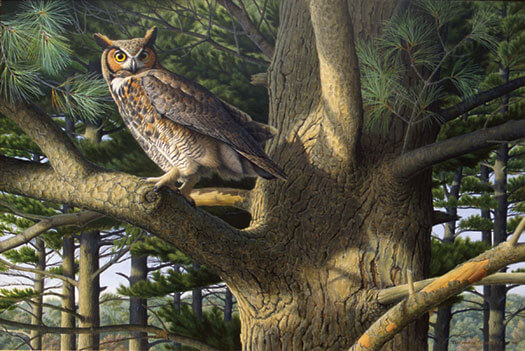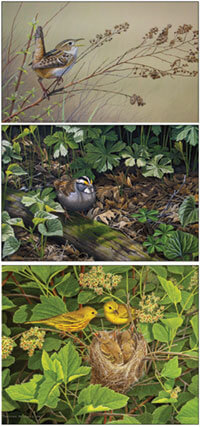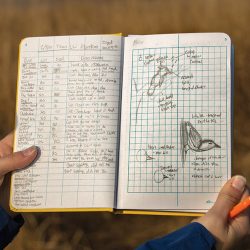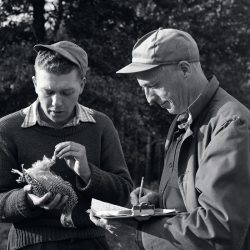Badger Birdman

Above: Guardian of the Pines — great horned owl, acrylic, 1989. In addition to creating images for field guides, Schultz also accepts commissions from private collectors.
Tom Schultz ’76 never dreamed he’d become a painter — but thanks to him, birdwatchers everywhere are able to identify their feathered friends.
Anyone who has reached for a bird guide to identify a mysterious warbler has probably seen Tom Schultz’s work. Though he came to UW-Madison to pursue an interest in aquatic biology, he was so entranced by the birds at Picnic Point that his passion soon shifted its focus from the lake to the sky above it.
After helping his resident adviser organize nature trips for local schoolchildren, Schultz began biking the short distance from his Lakeshore residence hall to Picnic Point three or four times a week.
“As I turned the corner into spring, my horizons were really broadened by the colors of the birds coming through in migration. It was a whole new world,” he says.
He spent every free minute sketching and painting the birds he saw while working toward his bachelor’s degree in wildlife ecology. Then Schultz participated in a painting seminar at the Asa Wright Nature Centre, the oldest nature center in the West Indies, with Don Eckelberry, a major player in bird illustration at that time. Returning to the States, he faced a crossroads. “To get a job in my major, I needed a master’s degree,” he recalls. “But my interest in painting was so strong, I found a temporary job selling shoes so I could spend all my non-work time in my studio.”
His effort was rewarded in 1981 when one of his paintings was accepted into the prestigious Birds in Art exhibit at the Leigh Yawkey Woodson Art Museum in Wausau. The show attracts artists from around the world, and the National Geographic Society sent its art director to the show to scout for artists for a new field guide.
Schultz was commissioned to help illustrate the National Geographic Field Guide to the Birds of North America. He spent the next two years meticulously painting gulls and terns, using specimens sent to him from the Smithsonian Institution. He has since illustrated many other guides, including more than half of the Houghton-Mifflin Peterson Series Field Guide to Warblers, the National Geographic Complete Birds of North America, and Birds of South Asia: The Ripley Guide. To prepare for the Ripley assignment, Schultz was flown to India for a six-week, whirlwind tour of what were once hunting compounds of Hindu princes (now Indian national parks). There he sketched and photographed every bird he could.

Top: Spring Song — sedge wren, acrylic, 2009. Middle: Spring Undergrowth — white-throated sparrow, oil, 1981. Bottom: Yellow Warblers at Nest, acrylic, 2006.
Schultz, who currently serves as president of the Wisconsin Society for Ornithology, recently returned from leading the group’s birding tour to Costa Rica for the eighth time. But most field trips he leads are in the Badger state. “Wisconsin is a wonderful place to watch birds,” says Schultz, who has a log home and studio outside Green Lake in the south central portion of the state.
In spring and fall, when birds are migrating, Schultz spends more time in the field, where he is active in bird identification and conservation. During winter, he spends more hours at his easel, where he can lose himself in painting the texture of a single feather. “Hawks, owls, shorebirds like sandpipers, sparrows, herons — I really enjoy them all,” he says. “Artistic opportunities are endless in the world of birds.”
In 2008, however, Schultz feared that those opportunities might come to an end. Worsening headaches were limiting the time he could paint, and after six months, he was diagnosed with a brain tumor. “We could tell from the look on the doctor’s face that it was a serious matter. I was at UW Hospital the next day [for surgery],” he says.
Although he was unable to paint for the next month as he recovered, Schultz was scheduled to lead a tour to Costa Rica in three months, and he was determined to keep his commitment. “It helped me speed my recovery,” he says. “I started a walking program within a few days of returning home. At first, I could hardly walk one hundred yards, but by the tour, I could run two to three miles.”
Today Schultz has fully returned to painting. He regularly submits information to eBird, one of the world’s largest online bird databases, and he recently signed a contract to produce a field guide app for iPhones.
“I’m looking forward to this new direction,” he says. “Concentrating the most important and useful information about birds into a form that is easily absorbed by the general public has always been my goal. The more people are aware of the natural world around them, the more they will be interested in seeing it preserved.”
Denise Thornton ’82, MA’08 is a Madison-based freelance writer.
Published in the Fall 2012 issue



Comments
Theodore Morris September 16, 2012
A good life based on following your heart.
Jim Nowak September 17, 2012
Glad to see a fellow classmate from L. P. Goodrich High School in Fond du Lac living his dream!
Katharine Brenner September 22, 2012
I am currently living in a community that values the natural world. I moved there in part because the signage at the entrance to the village indicated it was a “Bird Sanctuary” Village. They are now designated as a Bird City Wisconsin community. I wonder if Mr. Schultz ever gives presentations in SE Wisconsin.
Dan Doeppers October 12, 2012
In addition to being a fine bird artist, Tom is a wonderful person with whom to be in the field–insightful, accurate to a high degree, and endlesy patient and good humored with those of us less accomplished than he.